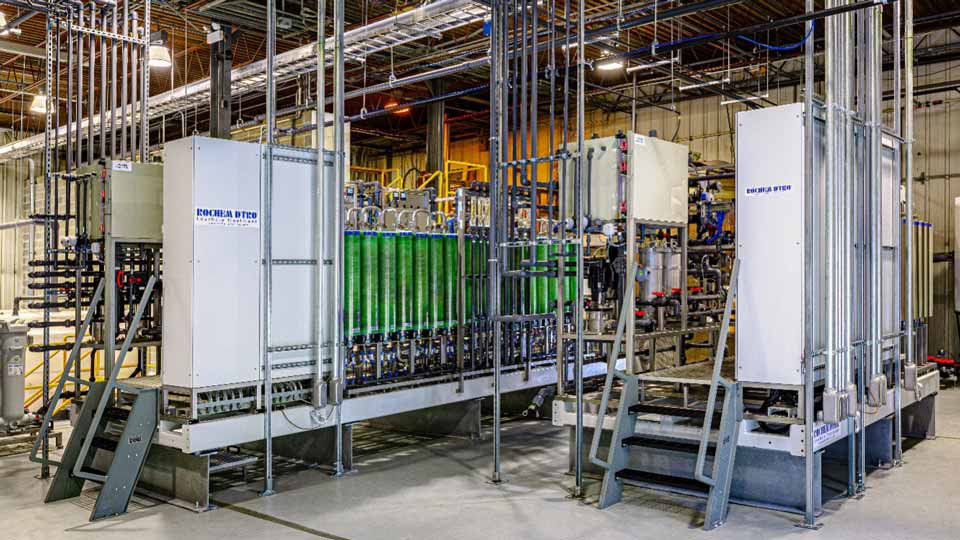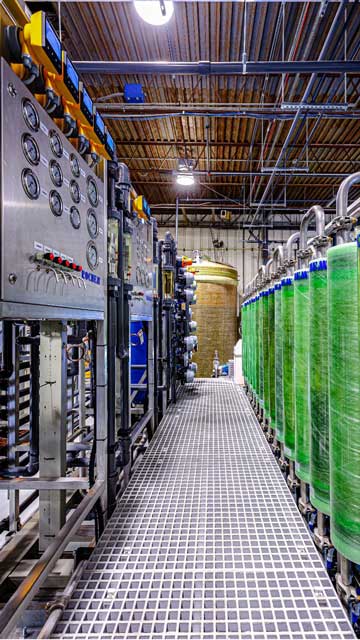Knocking Out PFAS With A Two-Punch Solution
April 13, 2023 by Brett Thompson, PE

PFAS is becoming a bigger concern for landfills—and operators need to know their options
If you look through the program for any solid waste conference these days, you’ll find at least one session about PFAS. The trade show will also have several booths with claims to “destroy PFAS.”
Yet many people in the solid waste sector feel that PFAS isn’t a priority. Should they be more worried? Yes.
In this article, you’ll learn what PFAS is and why it’s becoming more of a concern for landfill operation. You’ll learn why knocking out PFAS from your landfill’s leachate will likely require a two-hit solution, not just one. We’ll also look at how getting good at PFAS management can help set your landfill ahead in the race to deal with future regulatory hurdles.
As full disclosure, Rochem Americas manufactures and services products for one of the technologies discussed in this article, reverse osmosis.
Why the regulatory concern about PFAS?

Per-and Poly-fluoroalkyl Substances, collectively known as PFAS, were first developed over 50 years ago and used in a wide range of products, including stain resistant carpeting, firefighting foam, paints, cosmetics, breathable outerwear, and non-stick cookware.
Despite their usefulness, there’s increased scientific and regulatory concern about the impacts of PFAS. Given its widespread use, PFAS is virtually everywhere. It tends to bio-accumulate so it is concentrated in the top predators in ecological systems, as well as human beings.
Currently, PFAS compounds are believed to have health impacts at very low levels. Some currently have an US-EPA advisory limit of 70 nanograms per liter (parts per trillion). The EPA is proposing to designate two types of PFAS—PFOA and PFOS—as hazardous substances under the Comprehensive Environmental Response, Compensation, and Liability Act (CERCLA), also known as Superfund.
And because so much of what our society makes ends up in non-hazardous waste landfills, some of that PFAS makes its way into landfill leachate.
This can be particularly a concern for landfill operators who rely on wastewater treatment plants (WWTPs) for leachate treatment. WWTP operators, and their municipal owners, are becoming concerned about their environmental liabilities coming from their point of discharge, due to potential impacts to surface water and aquatic species. So, there is a good chance that more WWTPs will be saying “no” to landfill leachate.
One option is hauling leachate by truck for treatment elsewhere – but hauling gets expensive, and having many trucks on the road can be a strain on relations with the local community. Plus, it still leaves the landfill vulnerable to decisions by other entities about whether to deal with the leachate—for example by treatment or deep well injection—and at what cost. If a landfill gets cut off from its leachate treatment provider, it may need to go through a lengthy permitting process at the state level.
This means that many landfill operators prefer to maintain their independence and deal with their PFAS-laden leachate on their own.
Two problems, two solutions
The PFAS problem is really two problems in one—the difficulty of destroying the PFAS molecule, and the large volume of leachate produced by many landfills. It’s increasingly likely that the answers to the overall PFAS puzzle will require two different technologies.
In a previous article for MSW Management (“Don’t get stung by PFAS,” Sept–Oct 2019 issue) the former General Manager of Rochem Americas, Patrick Stanford, used his extensive background in landfill management to provide details on leachate treatment options.
Problem one: destroying PFAS
The first problem is the difficulty of making PFAS benign, so it is no longer a threat to human health or the environment.
This is challenging because PFAS molecules contain bonds between carbon and multiple fluorine atoms. These strong carbon-fluorine bonds give PFAS useful chemical properties for making products oil-, stain-, and water-repellent, or non-stick. But carbon-fluorine bonds are some of the strongest single bonds known to scientists, making PFAS extremely resistant to breakdown. This is why they’re often called “forever chemicals.”
Some of these technologies actively destroy the PFAS molecule. One of these is pyrolysis, which involves heating organic matter in the absence of oxygen to high temperatures—in the range of 500 to 800 degrees Celsius—which has been shown to break PFAS molecules. One downside to attempts to destroy the PFAS molecule through heat comes from the amount of energy needed to break that powerful carbon-fluorine bond.
Another possible technology is electro-oxidation, in which the PFAS-laden water passes by an array of electrodes, configured in a way that breaks down the PFAS molecules into shorter molecules including organics and fluorides. One disadvantage is that because leachate consists of so many other carbon compounds with weaker bonds, electro-oxidation requires a lot of energy to first destroy the other compounds and then to break the carbon-fluorine bond in the PFAS molecules.
Because of the difficulty of destroying PFAS molecules, it may be more practical to find ways to immobilize it, possibly by encasing it in impervious materials.
As we pointed out earlier, solid-waste conferences and trade shows offer many other technologies for breaking the PFAS molecule into something relatively less problematic. But one issue with many of these solutions is that for the most part, they have yet to show that they can operate at the scale required by landfill leachate processing, reliably, and cost-effectively.
Problem two: your options for reducing leachate volume
That’s why it’s essential to also solve the second problem with PFAS in leachate: sheer volume. There are few industrial processes that can match the flow of wastewater produced by a typical landfill, particularly one located in a moderate- or heavy-rainfall area.
This means that any solution for PFAS must include a way to reduce the size of the problem, by reducing the amount of leachate that must be treated.
Part of the answer comes with good landfill management: reducing the size of the open face, proper use of daily cover to keep precipitation out of the landfill, good use of tarpaulins, and other ways to divert precipitation so it does not have a chance to become leachate.
But leachate will always be with us. So, it’s important to find a way to separate the water that forms about 90 percent of leachate, from problematic constituents including PFAS. When it comes to costly treatment solutions, a smaller problem is a better problem.
One of the most common ways to reduce leachate volume is evaporation, often using landfill gas extracted on-site. This has the benefit of reducing methane emissions from the landfill, and it uses that gas to reduce another landfill operation problem, leachate.
However, many landfills have found another use for that gas: selling it to a third party either to generate what is considered renewable energy, or sending the treated landfill gas to become part of the natural gas stream. This makes evaporation of leachate cost-prohibitive for many landfills, and this trend is likely to continue.
But perhaps the biggest downside to evaporation as a way to deal with PFAS is that water (i.e., leachate) boils at 212 degrees F, which is not nearly hot enough to destroy the carbon-fluorine bond. So, what may happen is that PFAS-laden water vapor may get spread further.enough to destroy the carbon-fluorine bond. So, what may happen is that PFAS-laden water vapor may get spread further.
While PFAS can be absorbed by carbon or specialty absorbents, the complex mix of organics in leachate often interferes with targeted adsorption of PFAS. Due to their unique chemistry, these compounds do not break down in the environment, can bioaccumulate in higher organisms, and are difficult to remediate.
This brings us to membrane technologies for purifying leachate, including reverse osmosis (RO).
RO uses a semi-permeable membrane to remove ions, molecules and larger particles from wastewater. The result is that the residual leachate is retained on the pressurized side of the membrane and the permeate (RO-treated effluent) can pass to the other side. Unlike many treatment methods, RO offers the ability to separate out a wide range of constituents of concern, including PFAS (again, as full disclosure, this is the technology our company designs and manufactures).
Since 1997, Rochem has treated nearly two billion gallons of leachate at sites in North America and has installed a further 500 systems globally. Unlike many water treatment technologies, RO has a proven ability to scale to the leachate volumes produced by landfills today. It’s also proven to generate an effluent stream of a purity that can, in many cases, be permitted for release to surface water.
This is what allows the “one-two punch” idea from earlier, initial leachate treatment by a membrane technology such as RO to reduce the amount of problematic liquid, and then a further treatment to destroy, immobilize or otherwise deal with the problematic constituents such as PFAS.
Reverse Osmosis is a robust, proven technology for reducing the scope of the leachate problem.
Future-proofing your landfill
Another benefit of RO is that it’s able to extract virtually all the impurities found in leachate, making it adaptable to changing priorities. For example, one landfill that has been operating a Rochem RO unit on their leachate for many years was recently sampled for fluorinated compounds for the first time. They found that their system was already effectively treating the PFAS in their leachate. RO had effectively “future proofed” their operation to handle compounds that were not even considered for regulation when the system was installed.
This matters, because PFAS is just one of potential issues related to landfill leachate. PFAS joins a steady parade of materials including asbestos, lead and PCBs that were once used in many products, but are now considered problematic. Our industry needs to get accustomed to dealing with new constituents of concern, because that parade will likely just keep on coming.
Reverse osmosis can provide landfills with the first “hit” in a powerful two-part solution: RO to reduce the flow of liquid that needs to be treated, opening the door for technologies that can destroy problematic compounds such as PFAS.
About the Author
Brett Thompson, PE is Senior Applications Engineer with Rochem Americas, brett@rochemamericas.com. Note that Rochem is a developer and vendor of leachate treatment technology based on reverse osmosis. Contact us at: www.rochemamericas.com.

COME SEE US AT SWANA S.O.A.R. BOOTH #224, April 17-20th, Georgia World Congress Center, Atlanta
STOP BY OUR WASTE EXPO BOOTH #1761, May 2-4th, Ernest N. Morial Convention Center, New Orleans







Leave a comment